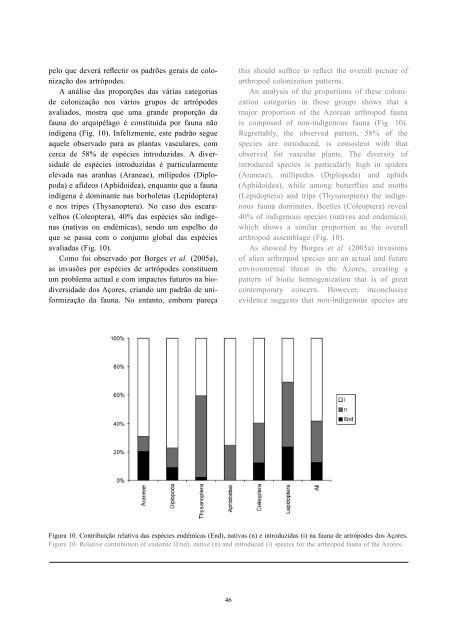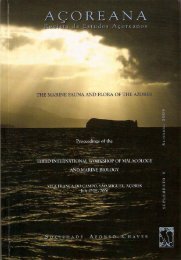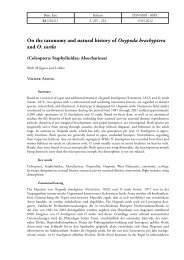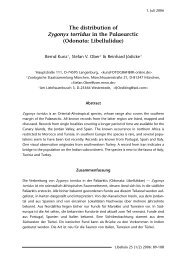(eds.) (2005). - Portal da Biodiversidade dos Açores - Universidade ...
(eds.) (2005). - Portal da Biodiversidade dos Açores - Universidade ...
(eds.) (2005). - Portal da Biodiversidade dos Açores - Universidade ...
Create successful ePaper yourself
Turn your PDF publications into a flip-book with our unique Google optimized e-Paper software.
pelo que deverá reflectir os padrões gerais de colonização<br />
<strong>dos</strong> artrópodes.<br />
A análise <strong>da</strong>s proporções <strong>da</strong>s várias categorias<br />
de colonização nos vários grupos de artrópodes<br />
avalia<strong>dos</strong>, mostra que uma grande proporção <strong>da</strong><br />
fauna do arquipélago é constituí<strong>da</strong> por fauna não<br />
indígena (Fig. 10). Infelizmente, este padrão segue<br />
aquele observado para as plantas vasculares, com<br />
cerca de 58% de espécies introduzi<strong>da</strong>s. A diversi<strong>da</strong>de<br />
de espécies introduzi<strong>da</strong>s é particularmente<br />
eleva<strong>da</strong> nas aranhas (Araneae), milípe<strong>dos</strong> (Diplopo<strong>da</strong>)<br />
e afídeos (Aphidoidea), enquanto que a fauna<br />
indígena é dominante nas borboletas (Lepidoptera)<br />
e nos tripes (Thysanoptera). No caso <strong>dos</strong> escaravelhos<br />
(Coleoptera), 40% <strong>da</strong>s espécies são indígenas<br />
(nativas ou endémicas), sendo um espelho do<br />
que se passa com o conjunto global <strong>da</strong>s espécies<br />
avalia<strong>da</strong>s (Fig. 10).<br />
Como foi observado por Borges et al. (<strong>2005</strong>a),<br />
as invasões por espécies de artrópodes constituem<br />
um problema actual e com impactos futuros na biodiversi<strong>da</strong>de<br />
<strong>dos</strong> <strong>Açores</strong>, criando um padrão de uniformização<br />
<strong>da</strong> fauna. No entanto, embora pareça<br />
46<br />
this should suffice to reflect the overall picture of<br />
arthropod colonization patterns.<br />
An analysis of the proportions of these colonization<br />
categories in these groups shows that a<br />
major proportion of the Azorean arthropod fauna<br />
is composed of non-indigenous fauna (Fig. 10).<br />
Regrettably, the observed pattern, 58% of the<br />
species are introduced, is consistent with that<br />
observed for vascular plants. The diversity of<br />
introduced species is particularly high in spiders<br />
(Araneae), millipedes (Diplopo<strong>da</strong>) and aphids<br />
(Aphidoidea), while among butterflies and moths<br />
(Lepidoptera) and trips (Thysanoptera) the indigenous<br />
fauna dominates. Beetles (Coleoptera) reveal<br />
40% of indigenous species (natives and endemics),<br />
which shows a similar proportion as the overall<br />
arthropod assemblage (Fig. 10).<br />
As showed by Borges et al. (<strong>2005</strong>a) invasions<br />
of alien arthropod species are an actual and future<br />
environmental threat in the Azores, creating a<br />
pattern of biotic homogenization that is of great<br />
contemporary concern. However, inconclusive<br />
evidence suggests that non-indigenous species are<br />
Figura 10. Contribuição relativa <strong>da</strong>s espécies endémicas (End), nativas (n) e introduzi<strong>da</strong>s (i) na fauna de artrópodes <strong>dos</strong> <strong>Açores</strong>.<br />
Figure 10. Relative contribution of endemic (End), native (n) and introduced (i) species for the arthropod fauna of the Azores.

















